-
TrimPlatinum
-
Engine3.0L Turbo V6
-
Power365 HP / 380 LB-FT
-
Transmission10-Speed Automatic
-
DrivetrainAWD
-
Engine PlacementFront
-
Curb Weight4,727 LBS
-
Towing5,600 LBS
-
Seating2+2+2
-
Cargo18.2 - 87.8 Cu. Ft.
-
MPG18 City / 24 HWY
-
Base Price$59,345 (Platinum)
PORTLAND, Ore. – People shopping for a three-row family crossover are bound to find that, beyond styling, the differences between models are awfully limited. That goes for dimensions, engine choices, and even underlying vehicle architecture. The new 2020 Ford Explorer is something different. While its styling is an evolution of the vehicle it replaces, this all-new, fifth-generation Explorer represents a radical transformation, offering a fundamentally different driving experience and capability set than both its predecessor and nearly every other family crossover.
Chief among the changes is the switch to a new rear-wheel-drive architecture — the only competitor not named Durango to utilize it. The benefits are several: improved dynamics, for one, but also uniquely sporty proportions, with a longer, lower hood, a shorter front overhang, and a longer wheelbase that benefits interior space. While the front and rear fascias are similar to the outgoing Explorer, the profile is profoundly different. The result is an SUV that looks like nothing else in its boxy segment.
Capability is also increased, as rear-wheel drive is beneficial for towing and for accepting higher power outputs. The 2020 Explorer's towing capacity stands at 5,300 pounds for the base 2.3-liter four-cylinder and 5,600 pounds with the Platinum trim's 3.0-liter turbo V6. By contrast, most competitors max out at 5,000 with optional equipment, and then on top of that, have less power and torque to deal with such heavy loads.

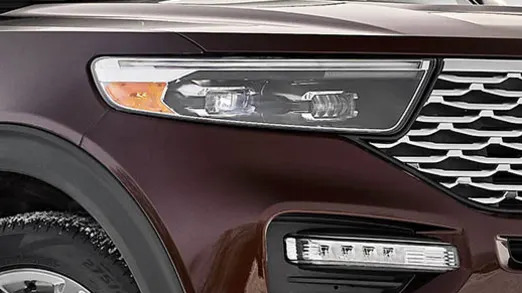
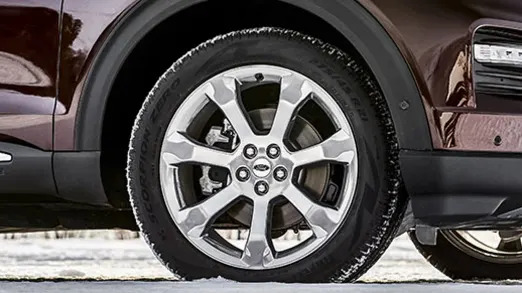
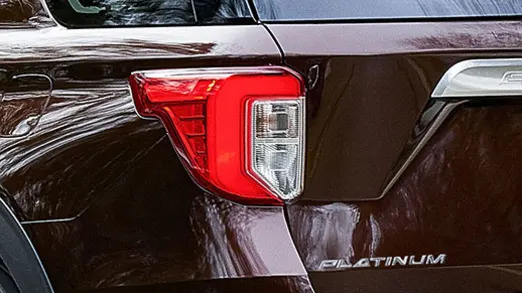
Indeed, the Explorer's 2.3-liter turbocharged inline-four that's standard on the base, XLT and Limited trims produces more horsepower (300) and substantially more torque (310 pound-feet) than the naturally aspirated V6s found in most competitors. Rear-wheel drive is standard on all trims except the Platinum and ST, all-wheel drive is optional, and every Explorer regardless of engine has a 10-speed automatic. The 2.3 offers such smooth, effortless torque — and with none of the wheel-wagging torque steer you can get from its front-drive-based rivals — that we wouldn't complain if it were the only engine offered. It's hard to imagine many potential customers complaining, either, especially since it matches the 23-mpg combined fuel economy of less powerful competitors like the Subaru Ascent and Mazda CX-9. ( The 2020 Ford Explorer Hybrid is reviewed in a separate piece. You can read about it here. - Ed.)
We didn't get a chance to tow with the 2.3, but did so with the 3.0-liter turbocharged V6 good for a whopping 365 horsepower and 380 pound-feet of torque that is exclusively paired with the range-topping Platinum trim. It didn't break a sweat towing a 3,500-pound camper, while a 4,800-pound boat and trailer combo required it to work noticeably harder. Still, it was easy to deduce how much harder it would've been for the average competitor that has 80 fewer horses and 110 fewer pound-feet of torque. The Platinum's brakes are also confidence-inspiring, the steering remains true despite added weight on the back end, and the 10-speed automatic is well-suited for towing.
There was no degradation in ride quality, either, beyond the expected extra rebound felt through the structure as the additional axle being towed behind you hits the same pavement imperfections. Indeed, with or without a boat, none of the Explorer versions we tested crashed unpleasantly over broken pavement despite wearing 20-inch wheels. Consecutive road undulations can cause the rather springy suspension to bob a bit, but no more so than is typical for the segment.
Of course, there's another reason to consider the Platinum and its turbo V6: exuberant acceleration that's quite frankly bonkers for a three-row family crossover. Nothing short of a V8-powered Dodge Durango comes close to it, but that porker also weighs about 800 pounds more (to be fair, it can also tow a couple thousand extra pounds). We also like that the big engine isn't paired to a variety of other performance upgrades — sometimes you just want the big engine without the racy brakes, firm suspension and various handling-enhancing accoutrement. If you do, of course, there's the 400-horsepower Explorer ST, which we will be reviewing later this week.
The Platinum and its turbo V6 come standard with the same all-wheel-drive system available as an option with the 2.3-liter. It operates generally with a 50/50 power distribution, but constantly moves power around as needed and can disconnect the front axle in steady cruising situations to save fuel. Ford's engineers indicated the torque split does not increase its rearward bias in Sport mode. Nevertheless, like various luxury cars that have a comparable all-wheel-drive layout, the Explorer maintains the balance and overall feel of a vehicle with rear-wheel-drive architecture. Even if its steering isn't particularly feelsome and the suspension pretty springy, there's an underlying sense of composure and even athleticism when hustling it along that you're just not going to get in the Tellurides and Pilots of this world.
Still, the Explorer's driving feel does differ depending on engine and drivetrain choice. A rear-wheel-drive XLT we tested had a noticeably lighter and crisper turn-in than the V6-powered all-wheel-drive Platinum. Having a lighter engine over front wheels unburdened by drive shafts tends to do that, and contributes to greater agility and eagerness to change direction. We didn't get a chance to test an all-wheel-drive XLT, but suspect it would be closer to other four-cylinder Explorers than the Platinum.
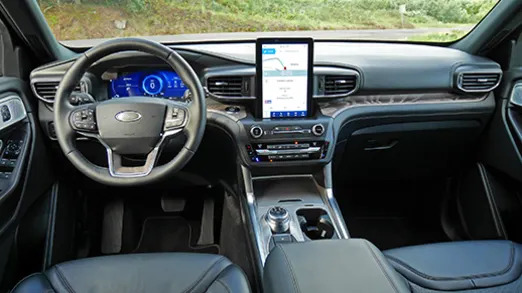
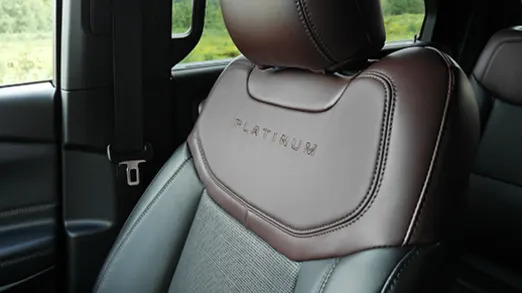
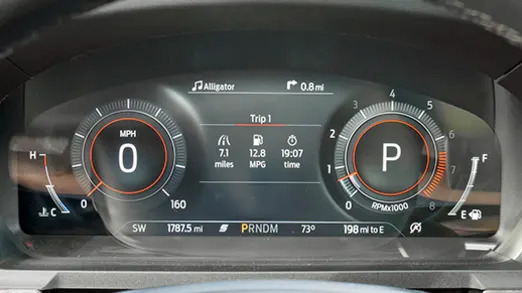
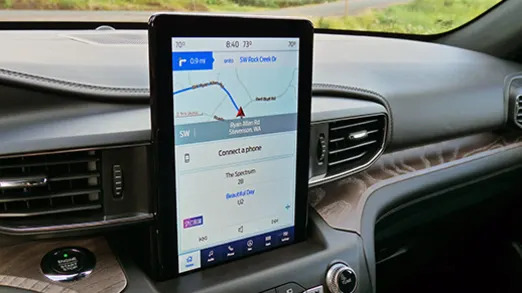
Inside, the design is a real improvement over the last Explorer, and more visually interesting than a Honda Pilot or Subaru Ascent. However, the Kia Telluride and Hyundai Palisade have a more premium vibe, even in lower trims and especially when their upper trim levels are compared to the leather- and wood-lined Platinum. The Explorer's overall quality of plastics is acceptable, nothing more.
Agreeably, the new driving position is just a little lower and more car-like than its competitors. While it maintains the expected commanding view of the road, you also feel like you're sitting in the Explorer as opposed to sitting on it, as in other crossovers. That, and the new dash, contribute to improved visibility and a less ponderous parking experience.
In the back, the new platform's longer wheelbase increases second-row legroom slightly, brining it in line with most of its competitors. Captain's chairs are standard on all but the base model, and on upper trim levels they slide forward for third-row access at the touch of a button. The resulting gap is as narrow, but similar to that of a Pilot, Telluride and 2020 Highlander. The VW Atlas, Dodge Durango and Chevy Traverse are appreciably better.
Once in the third row, you'll find a massive amount of headroom for even tall passengers. Unfortunately, that seems to be a side effect of a low-mounted seat bottom that forces legs skyward and makes it less comfortable than its competitors (despite having more legroom on paper). Raising the third-row seat bottom would've raised the load floor and reduced cargo capacity that, as it is, stands among the most generous in the segment. Unless you'll be routinely stuffing full-sized adults or teenagers in the third row, the trade-off will probably be acceptable, but it's not one the Explorer's largest competitors have.
We should also note that most Explorers can only seat seven people (with the bench seat standard on the base model and optional on all others), whereas its prime competitors are capable of eight thanks to a three-across third row. That said, it's not much of a practical disadvantage for the Explorer; fitting three across in those tiny spaces, even children, is a questionable proposition. The Explorer's effective capacity does reduce its perceived versatility.

Another potential downside for rear passengers is the lack of power: There are no USB ports in the third row, only one in the second, and a pair up front (one standard, one USB-C). A Kia Telluride has seven in total, spread throughout every row. We do like the wireless charging pad placed horizontally against the under-armrest bin, though, as well as the expansive covered bin that houses those front USB ports.
Elsewhere technology-wise, every trim comes standard with automatic emergency braking, lane-keeping assist and blind-sport warning. For infotainment, the standard 8-inch touchscreen is easy to see and reach, and benefits from Ford's generally user-friendly Sync 3 user interface. We also liked the extra smartphone-holding bin beneath it. That disappears with the 10.1-inch vertically oriented touchscreen (optional only on Platinum and ST), which doesn't improve functionality as you might expect. We could dig into more in-depth gripes, specifically in relation to Apple CarPlay integration as well as the information it shows when in split display mode, but suffice it to say, there is room for improvement. The Platinum's 12.3-inch digital instrument panel is far more successful and even changes its design based on the one of seven possible drive modes selected.
Of course, all of this talk of the Platinum has thus far sidestepped the landmine of its price: $59,345. By comparison, the most loaded Kia Telluride SX is $46,930, and a Honda Pilot Elite is $49,065. Is that rip-roaring turbo V6, plus those eye-catching screens, really worth $10,000? Given the base Explorer's ample capability, which can be had starting at a competitive, well-equipped $33,860, our answer is: not really. If anything, the big engine should be offered on a lower trim level. For instance, the Dodge Durango R/T and its 360-hp Hemi V8 starts at $45,490.
As such, it's best to put aside the Platinum, because if you need or desire your family hauler to be more than just a glorified minivan, even the 2020 Explorer's lower trim levels have the unique tools to be just that. Sure, its rear rows aren't as spacious as the class leaders', its cabin quality is unremarkable, and there's room for tech feature improvement. Its basic functionality as a family hauler is sound, but ultimately surpassed by top rivals. Yet, the new Explorer balances that with unmatched capability and performance, plus a driving experience that's different, and often better, than everything else. In the end, it makes for a far more noteworthy choice than if it was just another me-too crossover.
Chief among the changes is the switch to a new rear-wheel-drive architecture — the only competitor not named Durango to utilize it. The benefits are several: improved dynamics, for one, but also uniquely sporty proportions, with a longer, lower hood, a shorter front overhang, and a longer wheelbase that benefits interior space. While the front and rear fascias are similar to the outgoing Explorer, the profile is profoundly different. The result is an SUV that looks like nothing else in its boxy segment.
Capability is also increased, as rear-wheel drive is beneficial for towing and for accepting higher power outputs. The 2020 Explorer's towing capacity stands at 5,300 pounds for the base 2.3-liter four-cylinder and 5,600 pounds with the Platinum trim's 3.0-liter turbo V6. By contrast, most competitors max out at 5,000 with optional equipment, and then on top of that, have less power and torque to deal with such heavy loads.




Indeed, the Explorer's 2.3-liter turbocharged inline-four that's standard on the base, XLT and Limited trims produces more horsepower (300) and substantially more torque (310 pound-feet) than the naturally aspirated V6s found in most competitors. Rear-wheel drive is standard on all trims except the Platinum and ST, all-wheel drive is optional, and every Explorer regardless of engine has a 10-speed automatic. The 2.3 offers such smooth, effortless torque — and with none of the wheel-wagging torque steer you can get from its front-drive-based rivals — that we wouldn't complain if it were the only engine offered. It's hard to imagine many potential customers complaining, either, especially since it matches the 23-mpg combined fuel economy of less powerful competitors like the Subaru Ascent and Mazda CX-9. ( The 2020 Ford Explorer Hybrid is reviewed in a separate piece. You can read about it here. - Ed.)
We didn't get a chance to tow with the 2.3, but did so with the 3.0-liter turbocharged V6 good for a whopping 365 horsepower and 380 pound-feet of torque that is exclusively paired with the range-topping Platinum trim. It didn't break a sweat towing a 3,500-pound camper, while a 4,800-pound boat and trailer combo required it to work noticeably harder. Still, it was easy to deduce how much harder it would've been for the average competitor that has 80 fewer horses and 110 fewer pound-feet of torque. The Platinum's brakes are also confidence-inspiring, the steering remains true despite added weight on the back end, and the 10-speed automatic is well-suited for towing.
There was no degradation in ride quality, either, beyond the expected extra rebound felt through the structure as the additional axle being towed behind you hits the same pavement imperfections. Indeed, with or without a boat, none of the Explorer versions we tested crashed unpleasantly over broken pavement despite wearing 20-inch wheels. Consecutive road undulations can cause the rather springy suspension to bob a bit, but no more so than is typical for the segment.
Of course, there's another reason to consider the Platinum and its turbo V6: exuberant acceleration that's quite frankly bonkers for a three-row family crossover. Nothing short of a V8-powered Dodge Durango comes close to it, but that porker also weighs about 800 pounds more (to be fair, it can also tow a couple thousand extra pounds). We also like that the big engine isn't paired to a variety of other performance upgrades — sometimes you just want the big engine without the racy brakes, firm suspension and various handling-enhancing accoutrement. If you do, of course, there's the 400-horsepower Explorer ST, which we will be reviewing later this week.
The Platinum and its turbo V6 come standard with the same all-wheel-drive system available as an option with the 2.3-liter. It operates generally with a 50/50 power distribution, but constantly moves power around as needed and can disconnect the front axle in steady cruising situations to save fuel. Ford's engineers indicated the torque split does not increase its rearward bias in Sport mode. Nevertheless, like various luxury cars that have a comparable all-wheel-drive layout, the Explorer maintains the balance and overall feel of a vehicle with rear-wheel-drive architecture. Even if its steering isn't particularly feelsome and the suspension pretty springy, there's an underlying sense of composure and even athleticism when hustling it along that you're just not going to get in the Tellurides and Pilots of this world.
Still, the Explorer's driving feel does differ depending on engine and drivetrain choice. A rear-wheel-drive XLT we tested had a noticeably lighter and crisper turn-in than the V6-powered all-wheel-drive Platinum. Having a lighter engine over front wheels unburdened by drive shafts tends to do that, and contributes to greater agility and eagerness to change direction. We didn't get a chance to test an all-wheel-drive XLT, but suspect it would be closer to other four-cylinder Explorers than the Platinum.




Inside, the design is a real improvement over the last Explorer, and more visually interesting than a Honda Pilot or Subaru Ascent. However, the Kia Telluride and Hyundai Palisade have a more premium vibe, even in lower trims and especially when their upper trim levels are compared to the leather- and wood-lined Platinum. The Explorer's overall quality of plastics is acceptable, nothing more.
Agreeably, the new driving position is just a little lower and more car-like than its competitors. While it maintains the expected commanding view of the road, you also feel like you're sitting in the Explorer as opposed to sitting on it, as in other crossovers. That, and the new dash, contribute to improved visibility and a less ponderous parking experience.
In the back, the new platform's longer wheelbase increases second-row legroom slightly, brining it in line with most of its competitors. Captain's chairs are standard on all but the base model, and on upper trim levels they slide forward for third-row access at the touch of a button. The resulting gap is as narrow, but similar to that of a Pilot, Telluride and 2020 Highlander. The VW Atlas, Dodge Durango and Chevy Traverse are appreciably better.
Once in the third row, you'll find a massive amount of headroom for even tall passengers. Unfortunately, that seems to be a side effect of a low-mounted seat bottom that forces legs skyward and makes it less comfortable than its competitors (despite having more legroom on paper). Raising the third-row seat bottom would've raised the load floor and reduced cargo capacity that, as it is, stands among the most generous in the segment. Unless you'll be routinely stuffing full-sized adults or teenagers in the third row, the trade-off will probably be acceptable, but it's not one the Explorer's largest competitors have.
We should also note that most Explorers can only seat seven people (with the bench seat standard on the base model and optional on all others), whereas its prime competitors are capable of eight thanks to a three-across third row. That said, it's not much of a practical disadvantage for the Explorer; fitting three across in those tiny spaces, even children, is a questionable proposition. The Explorer's effective capacity does reduce its perceived versatility.

Another potential downside for rear passengers is the lack of power: There are no USB ports in the third row, only one in the second, and a pair up front (one standard, one USB-C). A Kia Telluride has seven in total, spread throughout every row. We do like the wireless charging pad placed horizontally against the under-armrest bin, though, as well as the expansive covered bin that houses those front USB ports.
Elsewhere technology-wise, every trim comes standard with automatic emergency braking, lane-keeping assist and blind-sport warning. For infotainment, the standard 8-inch touchscreen is easy to see and reach, and benefits from Ford's generally user-friendly Sync 3 user interface. We also liked the extra smartphone-holding bin beneath it. That disappears with the 10.1-inch vertically oriented touchscreen (optional only on Platinum and ST), which doesn't improve functionality as you might expect. We could dig into more in-depth gripes, specifically in relation to Apple CarPlay integration as well as the information it shows when in split display mode, but suffice it to say, there is room for improvement. The Platinum's 12.3-inch digital instrument panel is far more successful and even changes its design based on the one of seven possible drive modes selected.
Of course, all of this talk of the Platinum has thus far sidestepped the landmine of its price: $59,345. By comparison, the most loaded Kia Telluride SX is $46,930, and a Honda Pilot Elite is $49,065. Is that rip-roaring turbo V6, plus those eye-catching screens, really worth $10,000? Given the base Explorer's ample capability, which can be had starting at a competitive, well-equipped $33,860, our answer is: not really. If anything, the big engine should be offered on a lower trim level. For instance, the Dodge Durango R/T and its 360-hp Hemi V8 starts at $45,490.
As such, it's best to put aside the Platinum, because if you need or desire your family hauler to be more than just a glorified minivan, even the 2020 Explorer's lower trim levels have the unique tools to be just that. Sure, its rear rows aren't as spacious as the class leaders', its cabin quality is unremarkable, and there's room for tech feature improvement. Its basic functionality as a family hauler is sound, but ultimately surpassed by top rivals. Yet, the new Explorer balances that with unmatched capability and performance, plus a driving experience that's different, and often better, than everything else. In the end, it makes for a far more noteworthy choice than if it was just another me-too crossover.

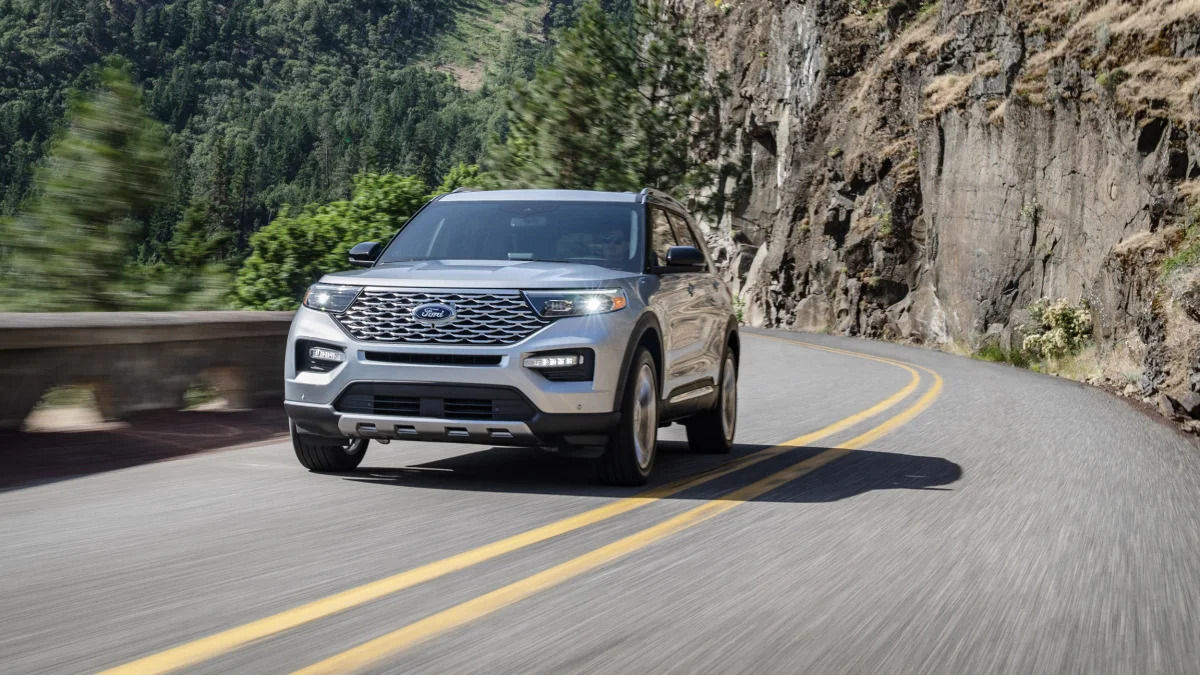









Sign in to post
Please sign in to leave a comment.
Continue